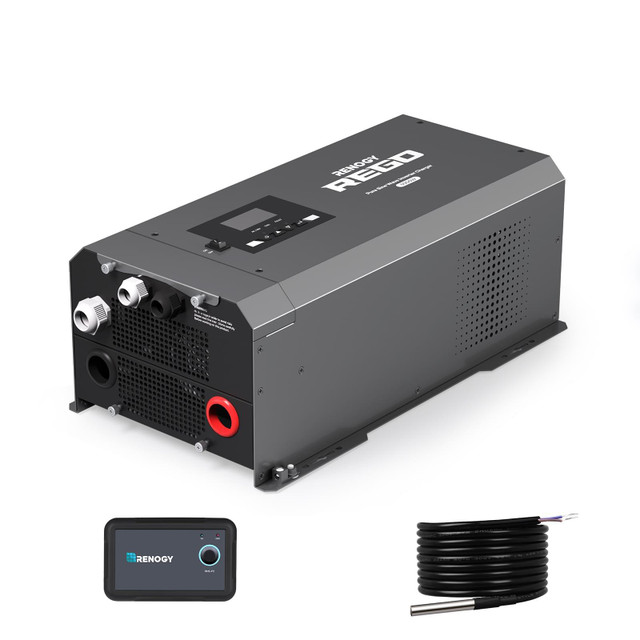In renewable energy systems and off-grid power solutions, inverter chargers serve as the backbone, ensuring a seamless energy conversion from one form to another. The REGO 12V 3000W Inverter Charger is a prime example of sophisticated engineering designed to meet diverse power needs efficiently. However, beyond its impressive technical specifications and functionalities lies a critical aspect often overlooked yet paramount to the system’s longevity and performance – proper cooling and ventilation.
Understanding the Heat Dynamics in Power Conversion
At its core, power conversion is a process fraught with energy loss, primarily in the form of heat. According to the inverter’s specifications, with nominal efficiency greater than 90%, a significant amount of energy is still dissipated as heat. If not managed effectively, this heat can lead to increased resistance, reduced efficiency, and premature aging of components. It’s here that cooling comes into play. Proper cooling mechanisms ensure that the heat generated during the inversion process is effectively dissipated, maintaining the system’s operational integrity and prolonging its lifespan.
The thermal management of power electronics is a complex interplay between ambient temperature, system design, and load conditions. For instance, as the load on the inverter increases, so does the heat produced. An academic perspective would involve thermodynamic calculations to quantify the heat losses under different operational scenarios, illustrating the critical need for effective cooling strategies in maintaining optimal performance.
The Safety Imperative
The safety implications of inadequate cooling are profound. High temperatures can lead to component damage, system failure, or even fire hazards, especially when dealing with high-voltage systems like the REGO 12V 3000W Inverter Charger. The manual’s detailed safety precautions underscore the risks associated with high temperatures and high-voltage operations. It’s a stark reminder of the fine line between functionality and safety, where proper cooling is about efficiency and preventing catastrophic failures.
From an academic standpoint, discussing the chemical and physical changes that occur within electronic components at elevated temperatures offers a deeper understanding of why cooling is an operational necessity and a safety-critical one.
Efficiency and Energy Loss
Let’s delve into the efficiency and energy loss aspects. The inverter’s efficiency rating indicates that a percentage of the input energy is invariably lost as heat. This loss is not just an operational cost but also an environmental concern. Inefficient energy conversion leads to higher operational costs and increased carbon footprint.
By applying the principles of energy conservation and thermodynamics, we can mathematically model the system’s efficiency under various cooling conditions. This highlights the importance of cooling from an operational cost perspective and underscores its environmental implications.
Operational Logic and Protection Features
The REGO 12V 3000W Inverter Charger has sophisticated operational logic and protection features. The power supply, charging, and heat dissipation logic work in tandem to ensure the system operates within safe thermal thresholds. Overcurrent protection and fault codes add layers of safety, shutting down the system or alerting users to potential overheating issues.
Academically, dissecting these features offers insights into the design considerations and engineering compromises inherent in power system design. It also provides a platform to discuss the algorithms and control mechanisms that govern these features, offering a glimpse into the intersection of thermodynamics, electronics, and computer science.
Technical Specifications and Real-World Application
Translating technical specifications into real-world applications involves understanding the scenarios where the inverter charger will be used. For instance, in a hot, enclosed space, the cooling requirements will be significantly different from those in a cooler, open environment.
By discussing case studies or hypothetical scenarios, we can explore how the inverter’s cooling needs change with the environment and usage patterns. This not only helps in understanding the practical applications of the technical specifications but also in designing more effective and situation-specific cooling strategies.
The Environmental Impact
Finally, the environmental impact of efficient energy conversion and proper system maintenance cannot be overstated. Inefficient systems require more power to perform the same work, leading to higher energy consumption and increased emissions. Proper cooling contributes to efficiency, ensuring that the system uses as little energy as possible to perform its function, thereby reducing its environmental footprint.
From an academic perspective, this can lead to discussions on sustainable design principles, the role of renewable energy systems in mitigating climate change, and the broader implications of energy efficiency on environmental policy.
Conclusion
In conclusion, the cooling of inverter chargers like the REGO 12V 3000W is not just a technical necessity but a complex interplay of safety, efficiency, and environmental responsibility. It demands a nuanced understanding of thermodynamics, material science, and environmental science. As we delve deeper into the age of renewable energy, the importance of these systems and their efficient operation becomes ever more critical. Proper cooling stands at the forefront of this challenge, ensuring that these systems not only meet our energy needs but do so safely and sustainably.
Solar Powered
Sustainable Off-Grid RV Solar Solutions
Designing, installing, and optimizing custom RV solar solutions for efficient, green, off-grid experiences.




